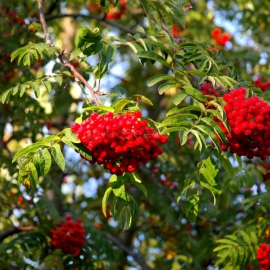







Organic Rowan Seeds (Sorbus Aucuparia)
1.14 €
Native to most of Europe except for the far south, and northern Asia this tough small to medium-sized tree is very tolerant of cold and exposure and is often found at high altitude on mountains-in the UK it occurs at up to 1 000m altitude.
-
Organic Rowan (Sorbus Aucuparia)
Native to most of Europe except for the far south, and northern Asia this tough small to medium-sized tree is very tolerant of cold and exposure and is often found at high altitude on mountains-in the UK it occurs at up to 1 000m altitude, higher than any other tree, and in French Alps up to 2000m.
It is very tolerant of a wide range of soil conditions, including chalky soils, thin acid soils and even cracks in cliffs. It grows best in an open sunny position but will tolerate some shade but the flowers and fruit will not be so prolific. Rowan's cope well with atmospheric pollution and is also suitable for coastal planting.
Trees are in flower from April to May, and the berries ripen from late July to September depending on the geographical area, in mild climates they will produce a heavy crop of fruit each year from around 8-10 years onwards. These fruit are an important food resource for many species of birds notably Redwings, Fieldfares, Blackbirds, Mistle Thrushes, Chaffinches and Waxwings.
The berries have a minor culinary use, due to the fact that they are usually quite bitter, but are used to make jam or jelly, with a distinctive bitter flavour, Rowan jelly is a traditional accompaniment to game and venison.
How to Grow
Rowan seeds have a deep dormancy within them, this requires a degree of patience to overcome and it is usually quite easy to get high levels of germination if the correct procedures are followed.
First prepare a free draining substrate into which the seeds are to be mixed, this can be a 50/50 mixture of compost and sharp sand, or perlite, vermiculite. The chosen substrate needs to be moist (but not wet), if you can squeeze water out of it with your hand it is too wet and your seeds may drown and die. Mix the seeds into the substrate, making sure that their is enough volume of material to keep the seeds separated.
Place the seed mixture into a clear plastic bag (freezer bags, especially zip-lock bags are very useful for this -provided a little gap is left in the seal for air exchange) If it is not a zip-lock type bag it needs to be loosely tied. Then write the date on the bag so that you know when the pretreatment was started.
The seeds first require a period of warm pretreatment and need to be kept in temperatures of 20 Celsius (68F) for a period of around 2 weeks . During this time make sure that the pretreatment medium does not dry out at any stage or it will be ineffective!
Next the seeds require a long cold period to break the final part of the dormancy, this is achieved by placing the bag in the fridge at (4 Celsius or 39F) for 30 weeks (although it is possible for germination to begin from the 16th week -so check the seeds every few weeks!). It is quite possible for the seeds to germinate in the bag at these temperatures when they are ready to do so, if they do, just remove them from the bag and carefully plant them up.
When the period of pre treatment has finished the seed should be ready to be planted. Small quantities can be sown in pots or seed trays filled with a good quality compost and cover them with a thin layer of compost no more than 1cm deep. For larger quantities it is easiest to sow the seeds in a well prepared seedbed outdoors once the warm and cold pretreatments have finished and wait for the seedlings to appear.
It has also been found that fluctuating pretreatment temperatures can give the best germination results and I have myself had excellent results by keeping the mixed seeds in a cold shed through the winter for the cold stage of their pretreatment and allowing the temperature to fluctuate naturally. Ungerminated seeds can have the whole warm and cold process repeated again to enable more seeds to germinate. Fresh seedlings can keep germinating for several years after the original sowing date.
All sorbus seeds will germinate poorly if the seedbed temperatures are too high. Try to keep soil temperatures below 15 Celsius by using shading if possible or seeds my go into a secondary dormancy. Keep the seedlings well watered and weed free.
Growth in the first year is usually between 10 and 50cm depending on the time of germination and cultural techniques and developing seedlings are usually trouble free. Allow them to grow for 1 or 2 years before planting them in a permanent position.
